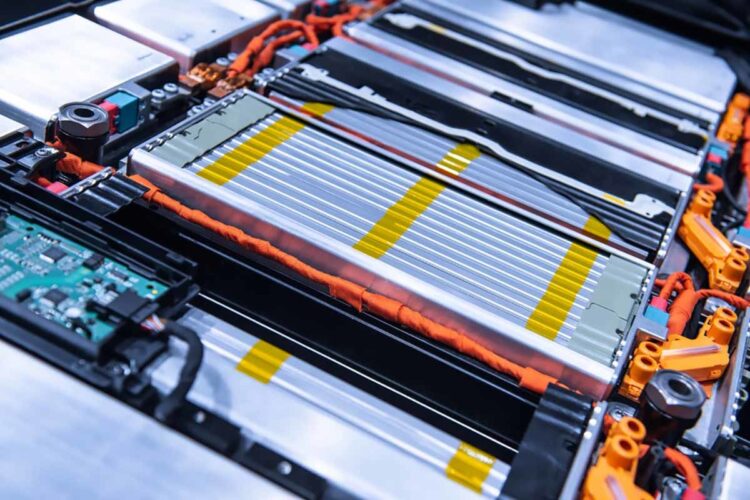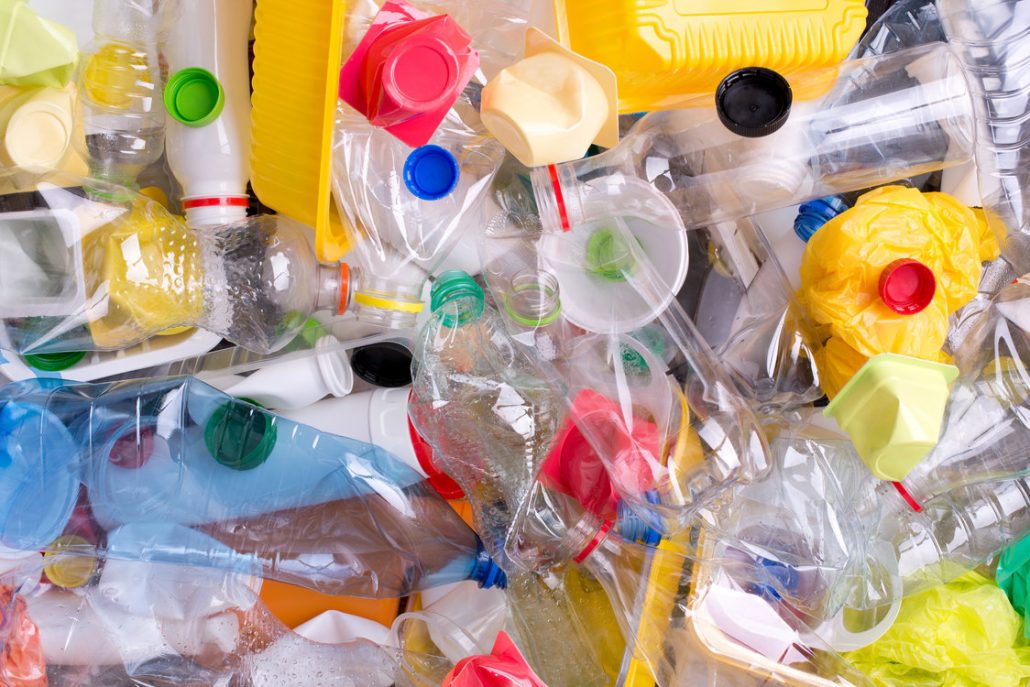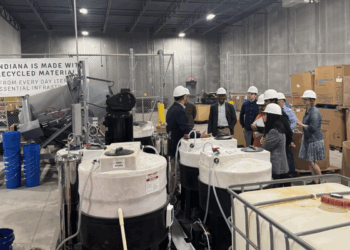Municipal collection events. Fire safety systems. Robotic sortation upgrades. These are a few of the numerous battery recycling efforts to receive a combined $62 million in government funding made possible by the Bipartisan Infrastructure Law.
The U.S. Department of Energy on March 28 announced 17 projects that will receive funds, broadly linked by a goal to improve consumer access to battery recycling and to improve the economics of battery processing.
The selected projects include efforts from companies such as robotics suppliers AMP and MOLG and e-scrap processor ERI. They also include municipal programs around the country, multiple national laboratories, haulers and more.
All of the projects target batteries from consumer electronics, but the ultimate goal is tied to the larger-format batteries found in electric vehicles.
“With demand for electric vehicles and stationary energy storage projected to expand the lithium battery market as much as ten-fold by 2030, investments in sustainable, reduced-cost recycling of consumer batteries are critical to securing the domestic materials supply chain to meet that demand,” the DOE stated in the funding announcement.
A separate round of funding opened on Feb. 20, making an additional $15 million available to improve retail collection of consumer device batteries. Additionally, the DOE announced $4 billion in tax credits, including for companies engaged in “clean energy manufacturing and recycling,” and for “critical materials recycling, processing and refining,” although it hasn’t publicly named the awardees.
The funding also comes shortly after the DOE announced grants to a number of recycling operations aimed at decarbonization.
These are the projects selected during the recent battery recycling funding round, sorted by the largest to the smallest dollar figure.
Expost Technology, based in San Diego, received $8.0 million to develop a pre-processing system for consumer devices to prepare them for safer handling. “This innovative system would integrate zero-emission shredding and extraction techniques to eliminate electrochemical and chemical hazards from batteries, mitigating the risks of fire and chemical incidents during transportation.”
Li Industries of Pineville, North Carolina, was awarded $7.0 million to “develop an automated, integrated sorting and preprocessing solution which will be faster and more cost‐effective for recycling end‐of‐life consumer electronics batteries. This project aims to reduce transport costs by consolidating all sorting and pre‐processing steps in one facility.”
AMP of Louisville, Colorado, received $6.4 million to demonstrate the viability of a system that automatically characterizes and sorts batteries contained within e-scrap devices. The project seeks to “establish a sorting process with at least 25% efficiencies over the state of the art, if not substantially more, which will drive expanded profitable consumer battery collection and conversion in the US through artificial intelligence and automated sorting techniques.”
Reaction Engineering International of Salt Lake City, Utah, was awarded $5.5 million to develop a pre-processing system for lithium-ion batteries. As part of the project, Reaction Engineering will build a pilot system mounted on a trailer with a capacity of 20 kilograms per hour, to be demonstrated in the local area as a way of educating the public about battery recycling.
MOLG, a robotics firm based in Chantilly, Virginia, received $5.2 million to improve the process of dismantling end-of-life PC laptop batteries. The project will deploy five robotic systems that will dismantle commonly used PC laptops and laptop batteries, aiming to do it for 50% the cost of current state-of-the-art technology. The project also includes an effort to get PC companies to alter laptop and battery design allowing for easier disassembly.
Harris County of Texas received $4.9 million for a partnership with the Houston Zoo to “increase participation by consumers in electronics and battery recycling in Harris County through the use of new interactive educational installations and displays and a behavior change education campaign.”
ERI, a nationwide e-scrap firm headquartered in Fresno, California, received $4.8 million to work with a group of stakeholders tackling various obstacles to greater battery recycling at the consumer and e-scrap processor level. The project includes creating a web-based outreach platform.
Argonne National Laboratory in Lemont, Illinois, received $4.0 million to explore materials or processes that will reduce costs and improve safety of battery transportation and processing. The project is focused on “solutions that utilize a combination of phase change materials and polymeric aerogels to create a flame retardant highly insulating package, develop safe shredding or automated dismantling of devices so workers are not needed to manually remove the battery, and utilize the tools developed for direct Li-ion battery recycling and other sorting technologies to sort out LiCoO2 from a device that has been shredded.”
UHV Technologies of Fort Wayne, Indiana, received $4.0 million to use artificial intelligence in developing a system that would identify and remove batteries from the municipal solid waste stream that’s headed for a landfill. The project is described as a “low-cost modular system for collecting and recycling consumer batteries from MSW using artificial intelligence.”
Idaho National Laboratory in Idaho Falls, Idaho, received $3.0 million to compare e-scrap device collection in states with and without state e-scrap laws. The project aims to “organize new e-waste collection events in Idaho and New York to increase collection volume by 15% compared to baseline. To this end, the project will conduct sociodemographic surveys, targeting 30% participation rate and educate students via school visits and collection contests, with the aim of averaging 0.25 pounds of battery-containing e-waste per student.”
The New York City Department of Sanitation was awarded $2.15 million to hold at least 200 mobile battery collection drop-off events across each of the city’s five boroughs, to implement a marketing campaign that reaches more than 1 million residents each year and to collect at least 35,000 pounds of batteries by the end of the project.
The Illinois Environmental Protection Agency received $2.0 million to add at least 250 more household battery collection sites around the state. The goal is to have one site in every municipality of more than 10,000 residents, and one in every county that doesn’t have a municipality of that size. The project also aims to hold at least 1,200 more single-day collection events for state residents, and to “increase battery collection by at least 60 million AA lithium-ion equivalent batteries.”
Macalester College received $1.8 million to design and implement a battery sustainability and energy storage educational and outreach platform. “The project plans to change battery recycling behavior using three publicly facing prongs that are scalable and replicable.” These include a “permanent and a traveling public exhibit,” a training program for educators and an interactive map.
The Minnesota Pollution Control Agency received $1.25 million to supply fire suppression systems to county and tribal battery collection programs around Minnesota.
Lane County Public Works Waste Management Division of Eugene, Oregon, received $1.0 million to build a battery storage facility at the agency’s existing transfer station, with a maximum capacity to hold 60,000 batteries at a time. The money will also go toward holding six household hazardous waste collection events, providing outreach to county residents and increasing battery collection by 20,000 pounds per year.
Onondaga County Resource Recovery of Syracuse, New York, received $700,000 to design and build a fire-safe facility where batteries are sorted by chemistry before being sent to a recycling processor. “The sorting facility will also include a fire-proof, short-term storage area for damaged, defective or recalled batteries, which will be accessible to pre-trained firefighters to improve safety and reduce fires.”
Merced County Regional Waste Management Authority, a California public agency, received $87,000 to “conduct outreach and education to increase constituent awareness about the importance of responsible battery disposal and recycling and establish battery drop-off locations at libraries, government offices and community centers in California.”
A version of this story appeared in Resource Recycling on Apr. 9.


























